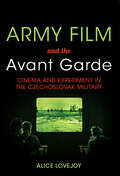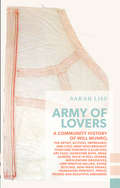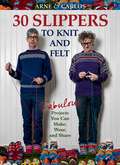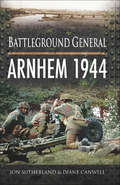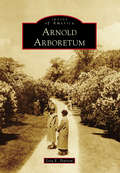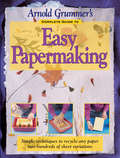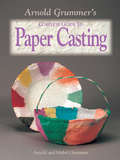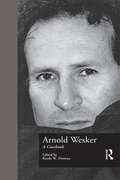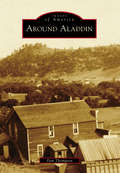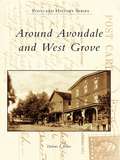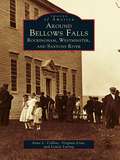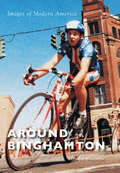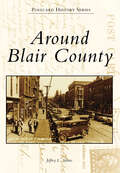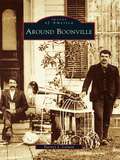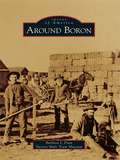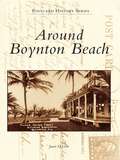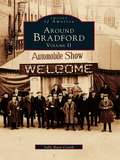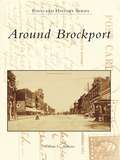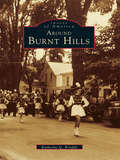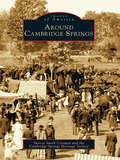- Table View
- List View
Army Film and the Avant Garde: Cinema And Experiment In The Czechoslovak Military
by Alice Osborne LovejoyDuring the 1968 Prague Spring and the Soviet-led invasion and occupation that followed, Czechoslovakia's Army Film studio was responsible for some of the most politically subversive and aesthetically innovative films of the period. Although the studio is remembered primarily as a producer of propaganda and training films, some notable New Wave directors began their careers there, making films that considerably enrich the history of that movement. Alice Lovejoy examines the institutional and governmental roots of postwar Czechoslovak cinema and provides evidence that links the Army Film studio to Czechoslovakia's art cinema. By tracing the studio's unique institutional dimensions and production culture, Lovejoy explores the ways in which the "military avant-garde" engaged in dialogue with a range of global film practices and cultures. (The print version of the book includes a DVD featuring 16 short films produced by the Czechoslovak Ministry of Defense. The additional media files are not available on the eBook.)
Army of Lovers: A Community History of Will Munro
by Sarah LissIn the spring of 2010, Toronto lost one of its most important queer civic heroes. Weaving together interviews and stories, Army of Lovers is a biography of Will Munro and a document of a galvanizing period when various subcultures - the queer community, the art scene, the independent music universe, the grassroots activist enclaves - came together.
Arne & Carlos-30 Slippers to Knit & Felt
by Carlos Zachrison Arne Nerjordet30 designs: Dozens of patterns, three different sizes, cuffs to keep your ankles cozy or clogs to slide on easily—sew on a pompom, a fringe, or an edging, and make them your own. Toe-curling comfort: Knitted with two strands of soft wool yarn for extra coziness and then felted to fit. Slippers the Arne & Carlos way: From classic Norwegian motifs and Sami-inspired moccasins to vivid flowers and playful rabbits—with step-by-step instructions, delightful photographs, and that Arne & Carlos charm!
Arnheim, Gestalt and Media: An Ontological Theory (SpringerBriefs in Philosophy)
by Ian VerstegenThis monograph presents a synthesis and reconstruction of Rudolf Arnheim’s theory of media. Combining both Arnheim’s well-known writings on film and radio with his later work on the psychology of art, the author presents a coherent approach to the problem of the nature of a medium, space and time, and the differentia between different media. The latent ontological commitments of Arnheim’s theories is drawn out by affirming Arnheim’s membership in the Brentano school of Austrian philosophy, which allows his theories to be clarified and strengthened, particularly with the metaphysical writings of Roman Ingarden. The resulting theory is relational, portraying essential medial differences with neutral criteria and allowing for a rigorous definition of a medium. The way in which a medium is based on the inherent dispositions of medial materials creates a highly appealing theory that is determinate without being deterministic. The theory is thus highly timely as people in media studies seek to address the determinate nature of media after the post-medium condition. The book will appeal to researchers and graduate students in cultural and media studies as well as architecture and design.
Arnhem 1944: Arnhem 1944 (Battleground General Ser.)
by Diane Canwell Jon SutherlandThis is the first in a series of game books which put you in command of the forces in engaged in some of history's most famous battles. Your tactical skill and ability to make the right command decision will be tested at every turn of the page. Operation Market Garden in September 1944 was one of the most daring Allied plans of the Second World War. An audacious surprise assault from the air, it was intended to give the Allies a bridgehead across the Rhine, removing the last significant natural barrier on the road to Berlin. If successful it might have shortened the war by months. Will the brave British paratroopers be able to seize the vital bridge at Arnhem and hold it until reinforcements fight their way through? Or will the Germans be able to recover the initiative and crush them in a skillful counterattack? The book presents you with a series of command decisions, aided by situation maps; directing you to the next relevant briefing depending on the option you choose. No dice are necessary to play, just this book and your tactical skill. When you buy this book, the fate of nations is in your hands.
Arnold Arboretum (Images of America)
by Lisa E. PearsonEstablished in 1872 and designed in collaboration with landscape architect Frederick Law Olmsted, the Arnold Arboretum is a National Historic Landmark. Founded as a partnership between the City of Boston and Harvard University, the Arnold Arboretum is a unique blend of a respected research institution and beloved public park in Boston's Emerald Necklace. Occupying 281 acres, its living collection of trees, shrubs, and woody vines is recognized as one of the most comprehensive and best documented of its kind in the world. Its lilac collection is a springtime favorite of visitors, along with the magnificent rhododendrons, and in the fall, trees from maples to dawn redwoods provide a wonderful display of color. The living collection is supported by curatorial documentation, a herbarium, library and archival holdings, and a state-of-the-art research center. These facilities and holdings provide the basis for research and education of visitors, students, and scholars from around the world.
Arnold Grummer's Complete Guide to Easy Papermaking
by Arnold GrummerThe Fun and Easy Way to Make Beautiful Paper Step-by-step illustrated instructions for basic papermaking Methods to make handmade paper safe for scrapbooking 27 art and decorative techniques for endless variations Adding botanicals and other nonpaper ingredients If you set out to find the best papermaking teacher in the world, your search would lean to Arnold Grummer. Not only is his knowledge of the subject all-encompassing, but his methods are so simple and easy that he truly makes the process fun. And the results will amaze you - so many varieties of beautiful sheets of paper, so many ingenious ways to change the effect. Whether you use your paper for fun party invitations, elegant wedding invitations, personal greeting cards, or as framed art, you'll have the satisfaction of knowing you created it yourself. A champion of our planet, Arnold believes that "waste paper is not waste fiber" and shows how to recycle any and all types of paper. Unlimited resources are available in your office waste basket, without spending a penny on materials. Water and fiber blended to pulp, colored with inks and dyes already in the paper, produce stunning new sheets that are truly "art" in every sense of the word.
Arnold Grummer's Complete Guide to Paper Casting
by Arnold Grummer Mabel GrummerCast With Confidence! Are you intrigued by the look of dimensional paper but you're not sure where to begin? Unlock the mystery of this centuries old art form with the most comprehensive book available! This guide takes you from the very basics of paper casting to choosing the best pulp, molds, and release agents for your needs, so you'll be creating your own stunning paper-cast pieces in no time. This Essential Resource Includes • Simple instructions for making pulp, adding botanicals, enhancing your creations with glitter and paint, and making molds from everyday items like rubber stamps and brass plaques • A dozen unique projects you'll be proud to display • Clear step-by-step photographs and easy-to-follow instructions • Inspirational examples of paper-cast artwork, from scrapbook pages and greeting cards to bowls and framed calligraphy
Arnold Schwarzenegger: A Little Golden Book Biography (Little Golden Book)
by Diana MurrayHelp your little one dream big with a Little Golden Book biography about body-builder, movie star, and politician Arnold Schwarzenegger. Little Golden Book biographies are the perfect introduction to nonfiction for young readers—as well as fans of all ages!This Little Golden Book about Arnold Schwarzenegger--an immigrant from Austria who achieved the American dream and became Mr. Universe, an action movie icon, and the governor of California--is an inspiring read-aloud for young children and Terminator fans of any age. Look for more Little Golden Book biographies: • Betty White • Carol Burnett • Lucille Ball • Harry Belafonte • Julie Andrews • Dwayne Johnson
Arnold Schwarzenegger: The Life of a Legend
by Fiaz RafiqArnold Schwarzenegger – a bodybuilder-turned-real-estate mogul who turned an undefeated streak at the Mr Olympia contest into an astonishing film career and eight years as the governor of California – is, for many people, the embodiment of the American Dream. From humble beginnings in a small village in Austria, Schwarzenegger has come to symbolise the opportunities that exist for anyone willing to work hard – parlaying success and self-confidence into the influence to shape hearts and minds across the globe. Even today, whether he&’s campaigning against climate change or fist-bumping fellow strongmen at his self-titled athletic event, he&’s one of the few men on the planet who&’s recognisable from his first name alone. Arnold. Fiaz Rafiq uses in-depth interviews with Schwarzenegger&’s peers to tell the life story of the one-time Governator, featuring exclusive interviews with his personal and close friends, fellow bodybuilders and training partners, Hollywood co-stars, directors, executive producers, political personalities and journalists – all offering first-hand accounts of the man they know. Together, these voices show new dimensions to the Arnold we all think we know – from the driven young man who brought building into the mainstream to the passionate advocate for political change.
Arnold Wesker: A Casebook (Casebooks on Modern Dramatists)
by Reade W. DornanFirst Published in 1998. Routledge is an imprint of Taylor & Francis, an informa company.
Around Aladdin (Images of America)
by Pam ThompsonAladdin is located in northeast Crook County, in the far northeast corner of Wyoming. The town, the lowest settlement in the state at 3,749 feet, is surrounded by vast plains of waving grass, wooded mountains, and rolling hills. Coal mining brought the early families to the area and has since formed the histories and memories of the people who came and worked to build farms and ranches. Descendents of many of the original settlers still reside in the community, working and raising their families. Around Aladdin contains the stories and memories of those that came to make this part of Wyoming a place to call home for a long, long time.
Around Aledo (Images of America)
by Homer Norris Susan Mckeague KarnesIn the mid-19th century, a few hardy settlers of European descent carved out farms in the Clear Fork Valley of present-day Parker County, attracted by the area's springs, tributaries, and a burgeoning market in nearby Fort Worth. For centuries, Comanche and Kiowa had inhabited the land, and a period of dramatic conflict ensued, exacerbated by the Civil War absence of able-bodied husbands and sons. By 1880, ranches and settlements flourished, aided by the Fort Worth-Yuma cattle trail and a Texas and Pacific Railway line connecting Fort Worth to the county seat of Weatherford. As the first mail stop in the newly formed county, Aledo was briefly dubbed Parker Station before having its name changed in 1882--a bow to a railroad engineer's Illinois hometown. Today segments of Bankhead Highway, the nation's first paved transcontinental highway, wind around Aledo, the Annettas, Willow Park, and Hudson Oaks, thriving communities that offer a pastoral lifestyle minutes from the urban amenities of the Fort Worth-Dallas Metroplex. Mere fragments remain of Newburg, Prairie Hill, Willow Springs, and other old settlements, visible only to old-timers and lost to living memory.
Around Avondale and West Grove (Postcard History Series)
by Dolores I. RoweChester County was one of the three original counties established by William Penn, giving it a long history of settlement and growth. Around Avondale and West Grove features historic postcards from Avondale, Baker's Station, Chatham, West Grove, and the surrounding area. Jennersville, located in Penn Township, has close ties to the rose industry begun in London Grove. This area was a rich agricultural district that had many nurseries (including one of world renown), creameries, mushroom farms, horse farms, an experimental farm for research, and other agricultural ventures. White Clay Creek, now a federally designated wild and scenic river, supported many mills. Granite and marble supplied the quarry industry. The township's location along the main highways between Lancaster, Wilmington, Philadelphia, and Baltimore made it an important route for commerce.
Around Ballston Lake (Images of America)
by Katherine Q. BriaddyBallston is a scenic town located in Saratoga County, with a history that is as long as it is interesting. Katherine Q. Briaddy takes us along on a journey into Ballston's past, providing insight into the lives of Ballston's early residents. Encompassing the years between the late 1700s and the present, the photographs within depict the area as it has changed and evolved over the years. As you peruse through the over 200 images, you will visit Ballston's recreational draws, such as Ballston Lake and Forest Park. You will see the houses that survived the British and Indian invasion of 1780, and the trolleys and railroads that came with the advance of technology. You will tour through the mansions, manors, and humble farms of Ballston's residents; you will see interpretations of the town's landmarks by local artists. You will observe the way life used to be for those who chose to call Ballston home.
Around Bellows Falls: Rockingham, Westminster and Saxtons River
by Louise Luring Virginia Lisai Anne L. CollinsWith more than two hundred vintage photographs, Around Bellows Falls: Rockingham, Westminster, and Saxtons River explores the fascinating history of these southern Vermont communities. Located along the Connecticut River, Rockingham-the township that includes both Bellows Falls and Saxtons River-was chartered in 1752. Westminster, one of Vermont's oldest towns, was granted in 1736 as Township No. 1.Around Bellows Falls: Rockingham, Westminster, and Saxtons River chronicles the history of these communities up to the mid-twentieth century with photographs of historic homes, businesses, people, and well-known landmarks. In addition to views of the fantastic beauty of the area, this volume includes photographs of Vermont's oldest public building, the Rockingham Meetinghouse (built in 1787), and the Bellows Falls home of Hetty Green, the infamous "witch of Wall Street." Westminster's Cumberland County Court was the location of not only the Westminster Massacre but also the meeting that declared Vermont as a free and independent republic in 1777. Also included are vintage photographs of the scenic village of Saxtons River (named on the National Register of Historic Places), which once had a strong mill industry that took advantage of three falls along the river.
Around Binghamton (Images of Modern America)
by Jim MaggioreThe Greater Binghamton area’s undulating history mirrors that of its terrain. The area has evolved from a transportation center to a hub of manufacturing and technology and, with the expansion of Binghamton University and SUNY Broome Community College, a growing center of erudition. First, canal boats and trains dominated the landscape, then, cigars were produced in abundance, followed by shoes, simulators, and computers. Now, with Binghamton University expanding into downtown, student housing, breweries, and eateries fill Binghamton’s streets. The area has earned the monikers “Parlor City,” “Carousel Capital of the World,” “Sports Mecca,” and the “City of Festivals.” Binghamton’s cultural legacy is rich; besides being the home of professional baseball, bicycling, golf, hockey, running, and tennis, Binghamton’s annual celebrations have included Mural Fest, July Fest, Spiedie Fest, and Luma Fest.
Around Blair County
by Jeffrey L. AdamsSituated in the very heart of Pennsylvania, Blair County is bounded on the west by the formidable Allegheny Mountains. It was this natural barrier that stalled westward migration and encouraged early settlers to farm its lush, fertile valleys prior to the American Revolution. Carved out of Bedford and Huntingdon Counties in 1846, Blair County was home to many iron furnaces in the 1800s and was on the chosen path of the great Pennsylvania Canal. However, it was the Pennsylvania Railroad that utilized Blair County as its base of operations, thus creating a unique transportation-based economy. Today, Blair County is bisected by Interstate 99. This highway, which parallels a great Native American path, provides travelers with views of some of the loftiest mountains and the most picturesque scenery of the state.
Around Boonville (Images of America)
by Harney J. CorwinNestled in the Black River valley with the Tug Hill Plateau to the east and the Adirondack Mountains to the west, Boonville traces its origin to the failure of a grand investment scheme. In the mid-1790s, Gerrit Boon, agent for the Holland Land Company, purchased vast acreage in northern New York, hoping to establish a plantation for the production of maple sugar. When that enterprise collapsed, Boon founded a settlement in the remote wilderness. Adopting a paternalistic stance, he attracted settlers by extending financial assistance to farmers, artisans, and tradesmen. The village soon prospered, and dairy farming became the dominant industry. With the arrival of a canal and railroad in the mid-1800s, Boonville expanded to become the largest town between Watertown and Utica. Around Boonville documents the growth of the village and surrounding area, with special attention to local landmarks and scenery, industry and recreation, prominent leaders, and ordinary citizens.
Around Boron (Images of America)
by Barbara J. Pratt Twenty Mule Team MuseumIn the late 1920s, this high desert area with little water and unproductive soil held no attraction for most people, but the small community of Amargo provided a grocery store, gas station, and of course a saloon for the convenience of tenacious gold and borax prospectors. In 1938, after the large deposit of borax was discovered and mining had begun, a town hall meeting was called and Le Roy Osborne, supervisor of Pacific Coast Borax Company, suggested changing the name from Amargo to Boron. Boron is the fifth element on the periodic table and combines with other nonmetallic minerals to form a family of related minerals called borates; after this was explained to those gathered at the town hall meeting, Boron was unanimously chosen as its new name and the community was forever linked to the borax mining industry.
Around Boynton Beach
by Janet DevriesNamed for an early entrepreneur who arrived by boat in 1894, the tiny settlement of Boynton Beach emerged around the luxury hotel Maj. Nathan S. Boynton built on the beach. This enterprise brought carpenters, truck farmers, and railroad workers. Pineapple plantations, tomato fields, and citrus groves flourished. Shell shops, drift fishing, roadside fruit stands, and motor courts transformed the landscape. In Postcard History Series: Around Boynton Beach, author Janet DeVries uses more than 200 postcards from her own collection and others to show a carefree lifestyle long gone. Featured are picture postcards, some over 100 years old, of Boynton Beach and neighboring Briny Breezes, Ocean Ridge, Hypoluxo, and Gulf Stream.
Around Bradford: Volume II (Images of America)
by Sally Ryan CostikAround Bradford Volume II further looks at the history of the area as it has not been seen before. Once one of the largest cities in Pennsylvania, Bradford relied heavily on oil production in the 1880s for its success. Author Sally Ryan Costik allows us to glimpse into the "Age of Innocence" at the turn of the century before she endeavors to examine the city's own tumultuous past. In the 1920s, it was home to KKK activity, gangster slayings, and mob retaliation--events that contrast sharply with the images of Sunday school, industrial growth, and high society from "Millionaires Row"found in this collection. In the years following the Roaring Twenties, Costik takes a unique look at the Depression era through the eyes of sports fans. She chronicles Bradford's baseball team through the decade as they played within the PONY league circuit (comprised of Pennsylvania, Ontario, and New York). No history of Bradford would be complete without giving mention to the Bradfordians who supported the war effort on the home front.
Around Brockport
by William G. AndrewsThe first settlers came to the Brockport area soon after 1800. Located some twenty miles west of Rochester, the towns of Sweden and Clarkson, the village of Brockport, and a college were organized between 1814 and 1835. The Erie Canal, farm implement manufacturing, and higher education fostered their growth and prosperity in the mid-1800s. At Brockport, the United States became a continental nation, the Industrial Revolution came to agriculture, and popular literature came to American women. Today, Brockport is a remarkably well-preserved Victorian village on a revitalized Erie Canal, Clarkson and Sweden are havens for farming and commuting, and the college is an 8,500-student unit of the State University of New York. Around Brockport presents more than two hundred thirty images from private and public collections, many from glass negatives. They depict such aspects of the area's history as farm life in early Sweden, stately homes at Clarkson Corners, industrial plants in Brockport, and student activities at the normal school.
Around Burnt Hills (Images of America)
by Katherine Q. BriaddyAround Burnt Hills offers a unique glimpse into the history of this Saratoga County, New York, community and evokes a nostalgia for the way things used to be. Join Katherine Q. Briaddy in her second Images of America tribute to the people and places of Ballston. Discover an era preserved through the advent of photography and the pieces of history saved by those with an affinity for memories of yesteryear. This volume is made up of a series of love letters found in the attic of a Burnt Hills homethat reveal much about the heritage of the town. They were written between 1926 and 1931, and the engaging stories within them complement the carefully preserved images found in Around BurntHills. All aspects of life are covered, from schoolsto Prohibition to politics and beyond.
Around Cambridge Springs (Images of America)
by Sharon Smith Crisman Cambridge Springs Historical SocietyIn 1903, Cambridge Springs was described in Cutter's Guide as "the Great Health and Pleasure Resort of Pennsylvania." Located in northwestern Pennsylvania on the banks of French Creek, it fell halfway between Chicago and New York City on the Erie Railroad. From the promotion of the mineral springs in 1884, this town of some six hundred people grew into a luxurious vacation spot that included accommodations such as the Riverside Hotel, the Rider Hotel, the New Cambridge Hotel (now the Bartlett), and more than forty other hotels and cottages. Around Cambridge Springs not only celebrates this town's golden age of resorts and affluence but also remembers the people, such as W.A. Baird Jr.; the places, such as Alliance College; and the events, such as the devastating fires of 1897 and 1931, that have shaped this community over the last two hundred years.
